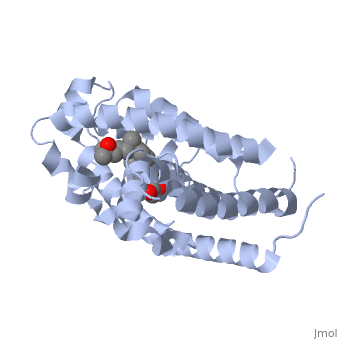1db1: Difference between revisions
No edit summary |
No edit summary |
||
| Line 3: | Line 3: | ||
== Structural highlights == | == Structural highlights == | ||
<table><tr><td colspan='2'>[[1db1]] is a 1 chain structure with sequence from [http://en.wikipedia.org/wiki/Homo_sapiens Homo sapiens]. Full crystallographic information is available from [http://oca.weizmann.ac.il/oca-bin/ocashort?id=1DB1 OCA]. For a <b>guided tour on the structure components</b> use [http://oca.weizmann.ac.il/oca-docs/fgij/fg.htm?mol=1DB1 FirstGlance]. <br> | <table><tr><td colspan='2'>[[1db1]] is a 1 chain structure with sequence from [http://en.wikipedia.org/wiki/Homo_sapiens Homo sapiens]. Full crystallographic information is available from [http://oca.weizmann.ac.il/oca-bin/ocashort?id=1DB1 OCA]. For a <b>guided tour on the structure components</b> use [http://oca.weizmann.ac.il/oca-docs/fgij/fg.htm?mol=1DB1 FirstGlance]. <br> | ||
</td></tr><tr><td class="sblockLbl"><b>[[Ligand|Ligands:]]</b></td><td class="sblockDat"><scene name='pdbligand=VDX:5-{2-[1-(5-HYDROXY-1,5-DIMETHYL-HEXYL)-7A-METHYL-OCTAHYDRO-INDEN-4-YLIDENE]-ETHYLIDENE}-4-METHYLENE-CYCLOHEXANE-1,3-DIOL'>VDX</scene>< | </td></tr><tr id='ligand'><td class="sblockLbl"><b>[[Ligand|Ligands:]]</b></td><td class="sblockDat"><scene name='pdbligand=VDX:5-{2-[1-(5-HYDROXY-1,5-DIMETHYL-HEXYL)-7A-METHYL-OCTAHYDRO-INDEN-4-YLIDENE]-ETHYLIDENE}-4-METHYLENE-CYCLOHEXANE-1,3-DIOL'>VDX</scene></td></tr> | ||
<tr><td class="sblockLbl"><b>Resources:</b></td><td class="sblockDat"><span class='plainlinks'>[http://oca.weizmann.ac.il/oca-docs/fgij/fg.htm?mol=1db1 FirstGlance], [http://oca.weizmann.ac.il/oca-bin/ocaids?id=1db1 OCA], [http://www.rcsb.org/pdb/explore.do?structureId=1db1 RCSB], [http://www.ebi.ac.uk/pdbsum/1db1 PDBsum]</span></td></tr> | <tr id='resources'><td class="sblockLbl"><b>Resources:</b></td><td class="sblockDat"><span class='plainlinks'>[http://oca.weizmann.ac.il/oca-docs/fgij/fg.htm?mol=1db1 FirstGlance], [http://oca.weizmann.ac.il/oca-bin/ocaids?id=1db1 OCA], [http://www.rcsb.org/pdb/explore.do?structureId=1db1 RCSB], [http://www.ebi.ac.uk/pdbsum/1db1 PDBsum]</span></td></tr> | ||
<table> | </table> | ||
== Disease == | == Disease == | ||
[[http://www.uniprot.org/uniprot/VDR_HUMAN VDR_HUMAN]] Defects in VDR are the cause of rickets vitamin D-dependent type 2A (VDDR2A) [MIM:[http://omim.org/entry/277440 277440]]. A disorder of vitamin D metabolism resulting in severe rickets, hypocalcemia and secondary hyperparathyroidism. Most patients have total alopecia in addition to rickets.<ref>PMID:2849209</ref> <ref>PMID:8381803</ref> <ref>PMID:1652893</ref> <ref>PMID:2177843</ref> <ref>PMID:8106618</ref> <ref>PMID:8392085</ref> <ref>PMID:7828346</ref> <ref>PMID:8675579</ref> <ref>PMID:8961271</ref> <ref>PMID:9005998</ref> | [[http://www.uniprot.org/uniprot/VDR_HUMAN VDR_HUMAN]] Defects in VDR are the cause of rickets vitamin D-dependent type 2A (VDDR2A) [MIM:[http://omim.org/entry/277440 277440]]. A disorder of vitamin D metabolism resulting in severe rickets, hypocalcemia and secondary hyperparathyroidism. Most patients have total alopecia in addition to rickets.<ref>PMID:2849209</ref> <ref>PMID:8381803</ref> <ref>PMID:1652893</ref> <ref>PMID:2177843</ref> <ref>PMID:8106618</ref> <ref>PMID:8392085</ref> <ref>PMID:7828346</ref> <ref>PMID:8675579</ref> <ref>PMID:8961271</ref> <ref>PMID:9005998</ref> | ||
| Line 37: | Line 37: | ||
</StructureSection> | </StructureSection> | ||
[[Category: Homo sapiens]] | [[Category: Homo sapiens]] | ||
[[Category: Klaholz, B | [[Category: Klaholz, B]] | ||
[[Category: Mitschler, A | [[Category: Mitschler, A]] | ||
[[Category: Moras, D | [[Category: Moras, D]] | ||
[[Category: Rochel, N | [[Category: Rochel, N]] | ||
[[Category: Wurtz, J M | [[Category: Wurtz, J M]] | ||
[[Category: Complex]] | [[Category: Complex]] | ||
[[Category: Gene regulation]] | [[Category: Gene regulation]] | ||
Revision as of 03:25, 23 December 2014
CRYSTAL STRUCTURE OF THE NUCLEAR RECEPTOR FOR VITAMIN D COMPLEXED TO VITAMIN DCRYSTAL STRUCTURE OF THE NUCLEAR RECEPTOR FOR VITAMIN D COMPLEXED TO VITAMIN D
Structural highlights
Disease[VDR_HUMAN] Defects in VDR are the cause of rickets vitamin D-dependent type 2A (VDDR2A) [MIM:277440]. A disorder of vitamin D metabolism resulting in severe rickets, hypocalcemia and secondary hyperparathyroidism. Most patients have total alopecia in addition to rickets.[1] [2] [3] [4] [5] [6] [7] [8] [9] [10] Function[VDR_HUMAN] Nuclear hormone receptor. Transcription factor that mediates the action of vitamin D3 by controlling the expression of hormone sensitive genes. Regulates transcription of hormone sensitive genes via its association with the WINAC complex, a chromatin-remodeling complex. Recruited to promoters via its interaction with the WINAC complex subunit BAZ1B/WSTF, which mediates the interaction with acetylated histones, an essential step for VDR-promoter association. Plays a central role in calcium homeostasis.[11] [12] [13] [14] Evolutionary Conservation Check, as determined by ConSurfDB. You may read the explanation of the method and the full data available from ConSurf. Publication Abstract from PubMedThe action of 1 alpha, 25-dihydroxyvitamin D3 is mediated by its nuclear receptor (VDR), a ligand-dependent transcription regulator. We report the 1.8 A resolution crystal structure of the complex between a VDR ligand-binding domain (LBD) construct lacking the highly variable VDR-specific insertion domain and vitamin D. The construct exhibits the same binding affinity for vitamin D and transactivation ability as the wild-type protein, showing that the N-terminal part of the LBD is essential for its structural and functional integrity while the large insertion peptide is dispensable. The structure reveals the active conformation of the bound ligand and allows understanding of the different binding properties of some synthetic analogs. The crystal structure of the nuclear receptor for vitamin D bound to its natural ligand.,Rochel N, Wurtz JM, Mitschler A, Klaholz B, Moras D Mol Cell. 2000 Jan;5(1):173-9. PMID:10678179[15] From MEDLINE®/PubMed®, a database of the U.S. National Library of Medicine. See AlsoReferences
|
| ||||||||||||||||
